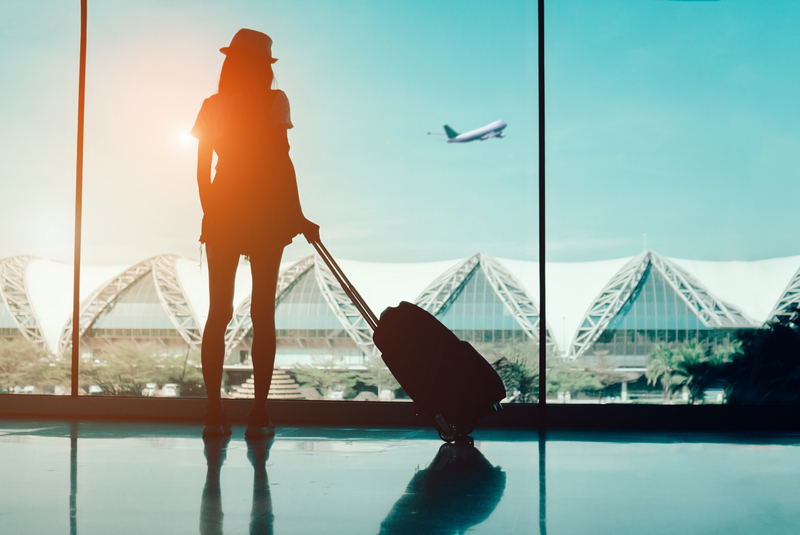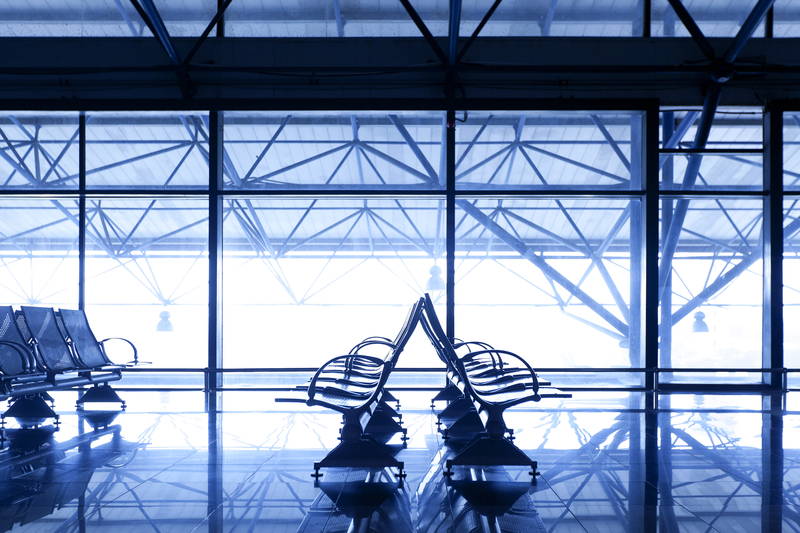Travel and tourism revenue is expected to decrease by nearly 35% in 2020, with up to 100 million jobs lost. Major airlines have already cut around 70,000 jobs, including major cuts from Lufthansa and British Airways, among others. The number of scheduled flights has decreased by 48% since this time last year as airlines eliminate routes and cut back on frequency of flights – and airlines could still lose $314 billion. The future of air travel is uncertain at best.
In the airport and on the plane, increased sanitation protocols, wearing of masks and social distancing are a few of the tips to stay safe for the future of air travel . They’re also creating a whole new flying experience for passengers. Airports are nearly empty. The restaurants, bars and duty-free shops within them are closed. Flying is certainly different these days – and according to the International Air Transport Association (IATA) air travel is not expected to return to normal until 2024.
New Policies and Safety Measures
With no vaccine expected until 2021, consumers continue to be concerned about the coronavirus, especially in enclosed spaces like airplanes. They’re also aware that travellers can spread the virus to new areas and cause a resurgence. In one IATA survey , 58% of respondents said they’re avoiding air travel, and 33% say they’ll continue to do so in the future. Their top concerns were being in a crowded area on the way to the plane – either on a bus or in line at the airport, sitting next to someone who might be infected, using the restrooms in the airport or on the plane, and breathing the air on the plane.
The fact that air travel is not expected to return to normal until 2024 means crowds in airports are naturally reduced, and they are also taking other precautions. The guidelines from the European Union Aviation Safety Agency (EASA) for airports and airlines include:
- Thermal screening at arrival airports
- Only ticketed passengers are allowed inside the airport
- Installation of hand sanitizing stations
- Masks must be worn by staff and passengers both on the plane and in the airport
- Recommended physical distancing of 1.5 meters
- Provide more buses to reduce crowding
- Reduced food and drink service
- No on-board duty-free sales
- Reduced capacity for carry-on luggage
The IATA study found that for the most part, passengers agree with these rules: 43% agree with undergoing temperature checks, 42% with wearing a mask and 39% with taking a coronavirus test before travel. Whatever the future of air travel looks like, it’s sure to include these measures for years to come.
While global air traffic is certainly affected by coronavirus fears, various travel bans are also having an effect. Most EU member states are allowing travellers from only certain non-EU countries to visit, and major countries like the US and Brazil aren’t on the list. Following recommendations from the European Council (EC), only residents of Australia, Canada, Georgia, Japan, New Zealand, Rwanda, South Korea, Thailand, Tunisia and Uruguay should be permitted to enter the EU. Canada and Australia have closed their borders to all foreign nationals. Many parts of Mexico are limiting all nonessential travel.
In addition to countries closing their borders, many governments are recommending their citizens not travel except for essential reasons. America has created a grading system from level 1 to 4 to rank the safety of countries epidemiologically. The European Commission has issued guidance for travellers that includes arriving early, checking in electronically, social distancing and wearing a mask.
All together, these new rules and regulations have had a chilling effect on air travel, and the drop in revenue is putting the future of aviation in jeopardy.
What This Means For Travel
Overall, global air traffic will remain below pre-pandemic levels until at least 2023, while revenue passenger kilometers or RPKs will catch up in 2024, says the IATA. Short-haul travel will recover more quickly than international travel, meaning that consumers will likely be more comfortable travelling domestically first. We’re already seeing this trend in several countries where “staycations,” road trips and short flights are becoming more popular. In some cases, this trend toward domestic travel may not be voluntary. Americans, for example, aren’t likely to be fully welcomed by much of the world until the virus is contained or there is a reliable vaccine. But this could create a long-term shift in travel habits as consumers may realize that domestic trips are more economical and just as enjoyable.
The effect that the coronavirus will have on the future of air travel will also vary depending on which country you are looking at. EU residents are free to travel among other EU member states, for example. Australians and New Zealanders are welcome in many parts of the world, but will actually face restrictions when returning home that could prevent many people from leaving in the first place. But emerging economies, which along with the US make up about 40% of global air traffic, are likely to be slow to recover, which will have a lasting effect on the travel industry.
Another area that makes a big difference in the speed of recovery – and in the IATA’s estimate that air travel is not expected to return to normal until 2024 – is business travel. With conferences cancelled, employees working from home and business meetings taking place virtually, business travel has essentially ground to a halt. According to the Global Business Travel Association , the sector could lose $820 billion in 2020. Even post-pandemic, remote work and virtual meetings will be more common than before as business realize benefits to their bottom lines. This could have a lasting effect on the future of aviation.
What This Means For Airline Companies
It will come as no surprise to airlines that air travel is not expected to return to normal until 2024. They’ve been on the front lines of the coronavirus and have already experienced some of its worst effects. Layoffs and cost-cutting have been widespread for both EU and American airlines:
- British Airways laid off about 12,000 people back in April
- American Airlines announced 5,000 job cuts in May
- SAS estimated it will need to cut 5,000 jobs
- EasyJet could lay off more than 4,500 employees
- Ryanair said it needs to get rid of 3,000 jobs to stay afloat
- Several subsidiaries of Norwegian Air have filed for bankruptcy
- Virgin Australia has also filed for bankruptcy protection
The list goes on. In America, the CARES Act, which included a variety of coronavirus-related legislation, provided a $25 billion dollar bailout to the airline industry, with the stipulation that they could not layoff employees until September 30. However, many airlines, such as those above, have already announced job cuts that will hit when the bill runs out at the end of September – and the future of air travel in America will be even more uncertain.
In Europe, many airlines have also received government bailout money , even those who have announced job cuts. The IATA recommends that governments continue with relief measures like these:
- Lufthansa received the largest bailout: €9 billion from the German government
- Air France was bailed out for €7 billion
- KLM received €3.4 billion from the Dutch government
- Swiss Airlines received €1.5 billion in relief from its government
In Europe, low-cost airlines may have a surprising advantage because they have more liquidity than higher-cost companies. A report from the Centre for Aviation found that Wizz Air and Ryanair have the highest liquidity of all European airlines, allowing them to avoid bailouts and even remain profitable – for now. Lufthansa, SAS and Norwegian had the lowest liquidity and are among the companies who have cut flights the most. If low-cost airlines survive, this could be good news for passengers: the future of air travel may be cheaper.
There’s another effect on both passengers and corporations: With air travel not expected to return to normal until 2024, airlines are having to cancel and delay more and more flights. In Europe, this is complicating the future of air travel even more due to EU 261, also known as the Passenger Rights Law. This law requires airlines that cancel or delay certain flights to refund passengers’ tickets, and in some cases also pay additional compensation.
The law has resulted in a battle between airlines and consumer rights organizations. Airlines are dragging their feet on providing refunds or outright refusing, and requiring consumers to accept vouchers for future travel instead. This helps airlines’ liquidity, but goes against Passenger Rights Law. Many governments are siding with airlines in a bid to save the industry from total collapse. But the European Commission is set on upholding the law, so if your flight has been delayed or cancelled, you may still be able to file a claim under EU 261.
The future of aviation is a big unknown, and its no wonder airlines aren’t prioritizing passenger rights in the current climate. You may need professional help to file your claim and ensure you get the compensation you’re entitled to. Travel Refund has years of expertise, and we’ll handle all the communication with the airline. We’ll even take them to court if needed. Airlines may be content to wait until air travel returns to normal in 2024, but passengers are not. You need your refund and compensation now, and we may be able to help you get it.


